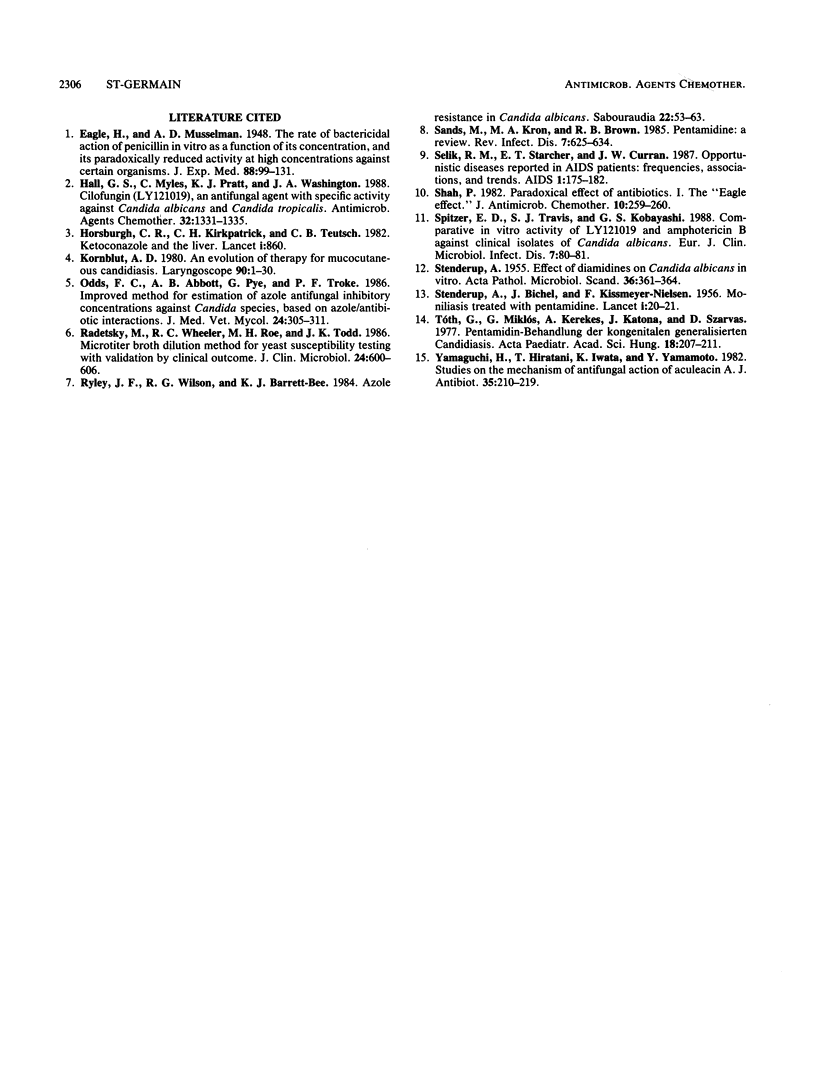Abstract
The in vitro interaction of pentamidine with ketoconazole and with itraconazole was studied with 10 strains of Candida albicans isolated from acquired immunodeficiency syndrome patients and one azole-resistant strain. Although growth curves indicated that concentrations of 1 microgram or more of pentamidine per ml significantly inhibited the growth of C. albicans, MICs and minimum fungicidal concentrations (MFCs) were greater than or equal to 10 micrograms/ml. Combinations of ketoconazole and pentamidine did not appear to have any significant effect on MICs or MFCs with most strains. However, the azole-resistant strain exhibited a 2-log decrease in MIC when exposed to ketoconazole combined with 1.0 microgram or more of pentamidine per ml. Similar results were obtained with itraconazole. An Eagle, or paradoxical, effect was observed with four strains exposed to itraconazole alone and in combination with 0.01 and 0.1 microgram of pentamidine per ml. This effect was not seen when concentrations of pentamidine reached 1.0 microgram/ml. Although no fungicidal effect was observed with any of these drugs alone, itraconazole combined with 10 micrograms of pentamidine per ml was fungicidal for eight strains. No signs of antagonism between pentamidine and these two antifungal agents were observed.
Full text
PDF


Selected References
These references are in PubMed. This may not be the complete list of references from this article.
- Hall G. S., Myles C., Pratt K. J., Washington J. A. Cilofungin (LY121019), an antifungal agent with specific activity against Candida albicans and Candida tropicalis. Antimicrob Agents Chemother. 1988 Sep;32(9):1331–1335. doi: 10.1128/aac.32.9.1331. [DOI] [PMC free article] [PubMed] [Google Scholar]
- Horseburgh C. R., Jr, Kirkpatrick C. H., Teutsch C. B. Ketoconazole and the liver. Lancet. 1982 Apr 10;1(8276):860–860. doi: 10.1016/s0140-6736(82)91915-8. [DOI] [PubMed] [Google Scholar]
- Kornblut A. D. An evolution of therapy for mucocutaneous candidiasis. Laryngoscope. 1980 Jul;90(7 Pt 2 Suppl 22):1–30. doi: 10.1288/00005537-198007001-00001. [DOI] [PubMed] [Google Scholar]
- Odds F. C., Abbott A. B., Pye G., Troke P. F. Improved method for estimation of azole antifungal inhibitory concentrations against Candida species, based on azole/antibiotic interactions. J Med Vet Mycol. 1986 Aug;24(4):305–311. doi: 10.1080/02681218680000461. [DOI] [PubMed] [Google Scholar]
- Radetsky M., Wheeler R. C., Roe M. H., Todd J. K. Microtiter broth dilution method for yeast susceptibility testing with validation by clinical outcome. J Clin Microbiol. 1986 Oct;24(4):600–606. doi: 10.1128/jcm.24.4.600-606.1986. [DOI] [PMC free article] [PubMed] [Google Scholar]
- Ryley J. F., Wilson R. G., Barrett-Bee K. J. Azole resistance in Candida albicans. Sabouraudia. 1984;22(1):53–63. [PubMed] [Google Scholar]
- STENDERUP A., BICHEL J., KISSMEYER-NIELSEN F. Moniliasis treated with pentamidine. Lancet. 1956 Jan 7;270(6906):20–21. doi: 10.1016/s0140-6736(56)91856-6. [DOI] [PubMed] [Google Scholar]
- STENDERUP A. Effect of diamidines on Candida albicans in vitro. Acta Pathol Microbiol Scand. 1955;36(4):361–364. doi: 10.1111/j.1699-0463.1955.tb04630.x. [DOI] [PubMed] [Google Scholar]
- Sands M., Kron M. A., Brown R. B. Pentamidine: a review. Rev Infect Dis. 1985 Sep-Oct;7(5):625–634. doi: 10.1093/clinids/7.5.625. [DOI] [PubMed] [Google Scholar]
- Selik R. M., Starcher E. T., Curran J. W. Opportunistic diseases reported in AIDS patients: frequencies, associations, and trends. AIDS. 1987 Sep;1(3):175–182. [PubMed] [Google Scholar]
- Shah P. M. Paradoxical effect of antibiotics. I. The 'Eagle effect'. J Antimicrob Chemother. 1982 Oct;10(4):259–260. doi: 10.1093/jac/10.4.259. [DOI] [PubMed] [Google Scholar]
- Spitzer E. D., Travis S. J., Kobayashi G. S. Comparative in vitro activity of LY121019 and amphotericin B against clinical isolates of Candida species. Eur J Clin Microbiol Infect Dis. 1988 Feb;7(1):80–81. doi: 10.1007/BF01962183. [DOI] [PubMed] [Google Scholar]
- Tóth G., Miklós G., Kerekes A., Katona J., Szarvas D. Pentamidin-Behandlung der kongenitalen generalisierten Candidiasis. Acta Paediatr Acad Sci Hung. 1977;18(3-4):207–211. [PubMed] [Google Scholar]
- Yamaguchi H., Hiratani T., Iwata K., Yamamoto Y. Studies on the mechanism of antifungal action of aculeacin A. J Antibiot (Tokyo) 1982 Feb;35(2):210–219. doi: 10.7164/antibiotics.35.210. [DOI] [PubMed] [Google Scholar]


